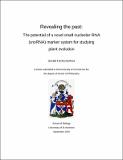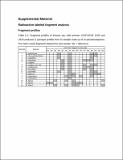Files in this item
Revealing the past : the potential of a novel small nucleolar RNA (snoRNA) marker system for studying plant evolution
Item metadata
| dc.contributor.advisor | Abbott, Richard J. | |
| dc.contributor.advisor | Brown, John W. S. | |
| dc.contributor.author | Hochschartner, Gerald | |
| dc.coverage.spatial | 292 | en_US |
| dc.date.accessioned | 2011-03-17T13:58:31Z | |
| dc.date.available | 2011-03-17T13:58:31Z | |
| dc.date.issued | 2011-06-22 | |
| dc.identifier | uk.bl.ethos.574830 | |
| dc.identifier.uri | https://hdl.handle.net/10023/1695 | |
| dc.description.abstract | Despite the existence of various molecular marker systems there are still limitations in distinguishing between closely related species based on molecular divergence, especially when hybridization events have occurred in the past. The characterisation of plant small nucleolar RNA (snoRNA) genes and their organisation into multigene clusters provides a potential nuclear marker system which could help in resolving the phylogenetic history of plants and might be applicable in DNA barcoding. Using closely and distantly related Senecio species, I investigated a combination of fragment length and sequence variation of snoRNA genes/snoRNA gene clusters to assess the utility of this marker system for barcoding and resolving species relationships. SnoRNA gene and gene cluster sequences identified in Arabidopsis thaliana were used to find homologues in other species and subsequently used for the design of universal primers. Most of the universal primer pairs designed were successful in amplifying snoRNA fragments in most Senecio species and fragment length variation between and within species could be detected. Furthermore, the combination of some fragment length datasets produced by different primer pairs enabled the separation of species and the detection of reticulate evolution indicating a high potential of snoRNA gene/gene cluster fragment length polymorphisms (SRFLPs) for phylogenetic reconstructions in Senecio and other plant genera. Most of the examined gene clusters showed a similar gene order in Senecio and Arabidopsis. However, the majority of these clusters appeared to exhibit more copies in Senecio, some of which were distinguishable by a combined sequencing/fragment profiling approach, and shown to be putative single copy regions with the potential to be used as co-dominant markers. However, a high number of paralogues and possible differences in copy number between species excludes these regions from being used in DNA barcoding. This is because specific primers would have to be developed for specific copies which would preclude development of a universal application for barcoding. None of the regions showed enough sequence variation to delimit distinctly closely related Senecio species and were therefore also considered to be unsuitable for DNA barcoding. Although most snoRNA genes and gene clusters might be inapplicable for DNA barcoding, they are likely to be valuable for phylogenetic studies of species groups, genera and families. On this scale, specific primers might act universally and the number of paralogous copies is likely to be equal across the species group of interest. | en_US |
| dc.language.iso | en | en_US |
| dc.publisher | University of St Andrews | |
| dc.subject | Small nucleolar RNA (snoRNA) | en_US |
| dc.subject | Molecular markers | en_US |
| dc.subject | Phylogenetics | en_US |
| dc.subject | DNA barcoding | en_US |
| dc.subject | Senecio | en_US |
| dc.subject.lcc | QH438.4B55H7 | |
| dc.subject.lcsh | Genetic markers | en_US |
| dc.subject.lcsh | Non-coding RNA | en_US |
| dc.subject.lcsh | Plants--Evolution | en_US |
| dc.subject.lcsh | Phylogeny | en_US |
| dc.subject.lcsh | Senecio | en_US |
| dc.title | Revealing the past : the potential of a novel small nucleolar RNA (snoRNA) marker system for studying plant evolution | en_US |
| dc.type | Thesis | en_US |
| dc.contributor.sponsor | University of St Andrews | en_US |
| dc.contributor.sponsor | Scottish Crop Research Institute | en_US |
| dc.type.qualificationlevel | Doctoral | en_US |
| dc.type.qualificationname | PhD Doctor of Philosophy | en_US |
| dc.publisher.institution | The University of St Andrews | en_US |
| dc.publisher.department | Scottish Crop Research Institute | en_US |
This item appears in the following Collection(s)
Items in the St Andrews Research Repository are protected by copyright, with all rights reserved, unless otherwise indicated.


